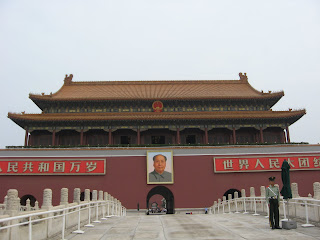It took us some time to get a suitable hotel room with our budget of less an RMB250 per night. Many hotels were meant for the China citizen only and some were not in good condition. We settled with a triple room in the hotel located in An Ding Men (安定门). The hotel rate was reasonable (RMB240) and the room was well kept as well. The only complaint was the air-conditioning could not function and we were told it was due to the local ruling for no air-conditioning in certain period.
Our top priority in Beijing is definitely the Imperial Palace or popularly known as Forbidden City. The Forbidden City was declared a World Heritage Site in 1987, and is listed by UNESCO as the largest collection of preserved ancient wooden structures in the world. The palace was built from 1406 for the duration of 14 years by the Emperor YongLe in Ming Dynasty. It was the permanent residence for a total of 24 emperors from the Ming and Qing dynasties until the last Qing emperor, FuYi, was evicted from the palace on 1924. It also houses the Palace Museum which was established on 1925.
It is located in Dongcheng District (东城区), in the centre of Beijing and is easily accessible by subway. Beijing has good subway infrastructure with many subway lines in the city and this was accelerated thanks to the Beijing Olympic 2008. The fare is also cheap with a flat rate of RMB2 with unlimited transfers applies to all lines except the Airport Express.
On the morning on 14 May, we walked to the nearest AnDingMen subway station (on line 2). After changing to line 1, we reached the TianAnMen West station. The first monument that captured our attention is the popular TianAnMen Gate. It was in fact the principal entry to the Imperial Palace during the Ming and Qing dynasties. We saw a portrait of Mao ZeDong in the centre. The Tiananmen Gate connects the Forbidden City precinct with Tiananmen Square.
Tiananmen Gate
The compound of the Forbidden City is large and is divided into 2 parts. The Outer Court includes the southern sections, and was used for ceremonial purposes. The Inner Court includes the northern sections, and was the residence of the Emperor and his family, and was used for day-to-day affairs of state.
Meridian Gate
After the Meridian Gate, we saw a large open square, pierced by the meandering Inner Golden Water River (see Photo below), which is crossed by five bridges. The Inner Golden Water River serves the decoration purpose as well as for fire control.
The Gate of Supreme Harmony (太和门) stands facing the square
 The Gate of Supreme Harmony
The Gate of Supreme Harmony
We saw a big square after the gate. A three-tiered white marble terrace rises from this square. There are 3 halls stand on top of this terrace. These are the Hall of Supreme Harmony - TaiHeDian(太和殿), the Hall of Central Harmony - ZhongHeDian (中和殿), and the Hall of Preserving Harmony- BaoHeDian (保和殿).The Hall of Supreme Harmony (see Photo below) is the largest hall within the Forbidden City. It was the location where Ming Dynasty and Qing Dynasty Emperors hosted their enthronement and wedding ceremonies.

The Hall of Supreme Harmony
It took us some time to visit (getting a bit of tired to walk in such a big compound) these halls. We proceeded to the Inner Court and visited the Palace of Heavenly Purity – QianQingGong (乾清宫), which was the residence of the Emperor.
 The Palace of Heavenly Purity
The Palace of Heavenly Purity The throne within the Palace of Heavenly Purity
The throne within the Palace of Heavenly Purity
 The Hall of Mental Cultivation (Internal)
The Hall of Mental Cultivation (Internal)We did not miss The Imperial Garden - YuHuaYuan, a private retreat for the imperial family and is the most typical of the Chinese imperial garden design. At each of the four corners of the garden there is a pavilion. These symbolise the four seasons. The Pavilion of Myriad Springs is the most famous and as it's name implies, this pavilion symbolizes spring.
 Pavilion within the Imperial Garden
Pavilion within the Imperial Garden
There were many exhibition rooms displaying various collections of the Palace Museum such as jewellery, ancient paintings, bronzes, mechanical timepieces etc. The precious collections were just plentiful and amazing.



We were getting hungry and exhausted by 2:00pm and decided to make a move. WangFuJing Street was our next destination. The popular Quanjude restaurant (全聚德) was our choice of restaurant as we just could not resist the temptation for the Peking Roast Duck, the signature dish in Beijing. It was a delicious, lightly-smoked, rich meal complimented by pancakes, dipping sauce, vegetable filling and irresistible slivers of juicy meat, fat and crispy skin. It was undoubtedly a perfect dining experience.















No comments:
Post a Comment